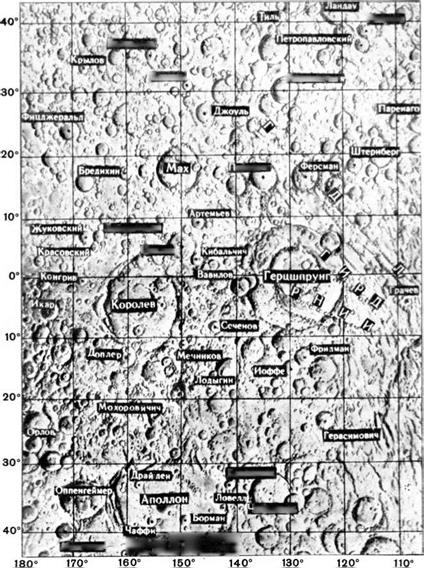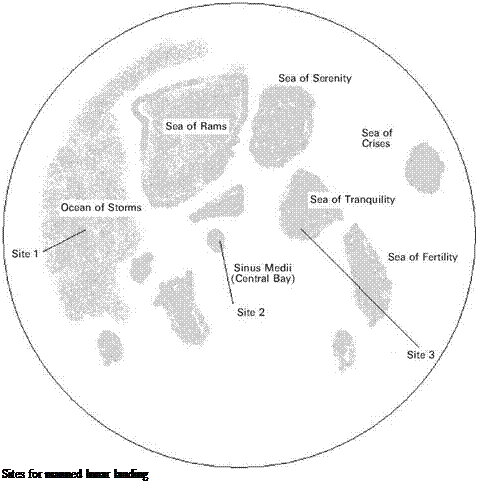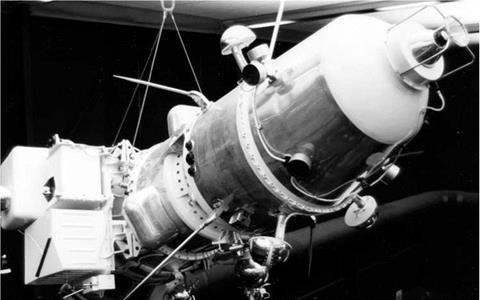THE LUNAR PHOTOGRAPHY MISSIONS
Now that lunar orbit had been achieved ahead of the Americans, the programme could now return to the original, planned Ye-7 lunar-orbiting photography mission. The Ye-7 was renamed the Ye-6LF at this stage. It used the same Ye-6 bus. Instead of the landing cabin, there was a non-detachable cone and box-shaped camera system. Luna 11 carried the same camera system as that flown on Zond 3, which in turn was designed for the 3MV series of Mars and Venus probes over 1964-5. The photographs were expected to cover 25 km2 each, with a resolution of 15 m to 20 m. Once taken, the photographs would be developed and dried. They would then be scanned by a television system on board. Besides the camera system, seven scientific instruments were carried, the same as the Ye-6S, Luna 10. The whole spacecraft weighed around
I, 620 kg.
The first Ye-6LF, with a full photographic suite on board, was eventually launched on 24th August, after the first American lunar orbiter had arrived. Called Luna 11, it left Earth on 24th August and entered moon orbit of 159 by 1,193 km, 27°, 2 hr 58 min. After burning propellant, the mass entering lunar orbit was in the order of 1,136 kg. The Russians had learned their lesson from the Luna 9 episode over the photographs. The Russians faced a choice of sending down pictures only when Yevpatoria was in line of sight, which would take many weeks, or to send them down when stations farther afield, including their own, could pick them up. They decided on the latter course. In a crafty ruse, the decision was taken that transmission would switch rapidly between the two downlink frequencies, too quickly for Jodrell Bank to reconfigure its systems. Moreover, all the photographs were to be taken in the first 24 hours of the mission and transmitted straight away, before this cat-and-mouse technique could be realized or countered.
The Russians reported completion of the mission on 1st October after 38 days, 277 revolutions and 137 communications sessions – but the long-awaited pictures were never published, nor was much else said. Only after glasnost did the Russians admit that the mission had failed in its primary purpose and that the pictures had never reached Earth in the first place. Although the cameras had worked, a problem with the thruster systems meant that the spacecraft had not been pointing at the moon at all, but taking pictures of blank space! This was due in turn to a foreign object getting stuck in one of the thrusters, making orientation impossible. Luna 11 also carried instruments to measure gamma rays, X-rays, meteorite streams and hard corpuscular radiation. Specifically, it was instrumented to confirm Luna 10’s detection of mascons. The scientific outcomes are not known and few lunar results were attributed to Luna 11. Russian accounts of the scientific results of the 1966 orbiting missions give details of outcomes from Luna 10 and 12, but not 11 [10]. Luna 11 carried, as did its successor, gears and bearings designed to be used on subsequent lunar rovers, to test how they would work in a vacuum.
Luna 12 (22nd October) passed the moon at 1,290 km at a speed of 2,085 m/sec when its retrorocket fired for 28 sec to cut its velocity to 1,148 m/sec to place it into an orbit of 100 by 1,737 km, 3 hr 25 min, in a much narrower equatorial orbit than Luna
II, only 15°. This time, lunar photography was the stated mission objective and
|
Luna 11, 12 design |
presumably this was accomplished on the first day during the low points of the orbital passes. Thrusters were used extensively to point Luna 12 toward landing sites and on the second day the spacecraft was put into a slow roll so as to accomplish the rest of its mission.
The whole mission lasted three months and ended on 19th January 1967 after 85 days, 602 orbits and 302 communications sessions. The imaging, scanner and relay system had a resolution of between 15 m and 20 m and could be transmitted at either 67 lines/frame for 125 sec (quick look) or at 1,100 lines a frame for 34 min (high resolution). The target areas were the Sea of Rains, Ocean of Storms and craters Ariastarcus and Alphonsus: a Soviet photograph released late in 1966 showed cosmonauts Yuri Gagarin, Alexei Leonov, Vladimir Komarov and Yevgeni Khrunov pouring excitedly over its pictures.
The Russians gave only a short account of the Luna 12 mission, the principal one being Luna 12 transmits, published in Pravda on 6th November 1966 and they released only a small number of images from Luna 12, much inferior in quality to the American
|
Luna 12 images |
lunar orbiters and doing less than justice to the 15 m resolution of the cameras [11]. There are some reports that the photographs were so poor that the Russians ended up resorting to assembling the publicly available American Ranger and Lunar Orbiter archive to plan their moon landings; but this could be a traditional Western underestimate of Soviet photographic capabilities. There is no suggestion that anything went wrong, so the pictures must have been at least up to the standards of Zond 3. Because they were taken at much closer range, they were probably much better. Either way, it is more than likely that there are still some Luna 12 pictures deep in some Moscow archive. In addition to cameras, Luna 12 carried a gamma ray spectrometer, magnetometer, infrared radiometer and micrometeorite detector. Assessments were made of the reflectivity of the lunar surface to infer its density (1,400 kg/m3).
Presumably, the Luna 12 pictures would have been decisive in determining where the Russians would land on the moon. The American lunar orbiters enabled the Americans to narrow down the choice of the first landing to five prospective sites, all near the equator (likewise, Luna 12 flew over the equatorial belt, between 15°N and 15°S, in a much narrower band than Luna 11, which operated between 27°N and 27°S). A team in the Vernadsky Institute, led by Alexander Bazilsvsky (b. 1937), worked on site selection for the manned landing from 1968 and also for soil sample and rover missions. Eventually, the Russians selected three smooth areas for the first manned landing on the moon: [2]
![]()
|
Евдокм»*ов’ |
|
[Ковалеве*» |
|
|
|
|
|
|
|
|
|


КлеАмеио»
Іебмшев
![]() наді vm
наді vm
Ye-6LF (originally Ye-7)
Height
Base
 Weight (payload) Orbiting altitude Angle to equator Orbital period
Weight (payload) Orbiting altitude Angle to equator Orbital period
 |
Ye-6 series: instruments specified1
Magnetometer.
Gamma ray spectrometer.
Gas discharge counters.
Electrode ion traps.
Meteoroid particle detector. Infrared radiometer.
Low-energy X-ray photon counter. Cameras (Ye-6LF).
|
Summary of lunar orbiters Ye-6S and Ye-6LF
 1 Mar 1966 31 Mar 1966 24 Aug 1966 22 Oct 1966
1 Mar 1966 31 Mar 1966 24 Aug 1966 22 Oct 1966













